Google Nexus 5 Review
by Brian Klug on December 5, 2013 8:00 AM EST- Posted in
- Smartphones
- LG
- Android
- Mobile
- Snapdragon 800
- Android 4.4
- Nexus 5
Display on mobile devices is one area where we’ve seen considerable improvement. Pixel density has gone up, contrast ratios have improved, and the emphasis on low power in a platform gated by its battery size means there’s always innovation happening.
In the case of the Nexus 5, there’s a considerable jump in resolution, from the WXGA 1280x768 display on the Nexus 4, to the now-standard 1080p. The biggest change is an obvious shift in aspect ratio from 15:9 to 16:9 once more. Back with the Nexus 4 and Optimus G, I noted just how surprisingly noticeable that extra 48 pixels of width was. Although we tend to think in absolute display resolution and talk about it quite a bit, Android uses display independent pixels or dips in order to keep layouts display density agnostic and support a wide variety of screen sizes and resolutions. Nexus 5 implements the 480 ppi or xxhdpi screen density, whereas Nexus 4 implements 320 ppi or xhdpi density. The result is that the Nexus 5’s display is 360x592 dips in size, compared to 384x592 dips for the Nexus 4, coming in 24 dips narrower. It’s important to note however that this change is intentional to maintain Android’s DPI independence, even if it does mean less overall real-estate in apps and browser.
Display quality is a big deal in the Android space, with lots of variance between devices. In the case of the Nexus 5, I started by tracking down the display type. If you recall, 5-inches with 1080p is a resolution we’ve seen before in the Droid DNA and Butterfly. From what I can tell, the Nexus 5 uses a very similar evolved version of that panel, a JDI (Japan Display, Inc) 1080p display with in-cell touch courtesy Synaptics ClearPad 3350 solution.
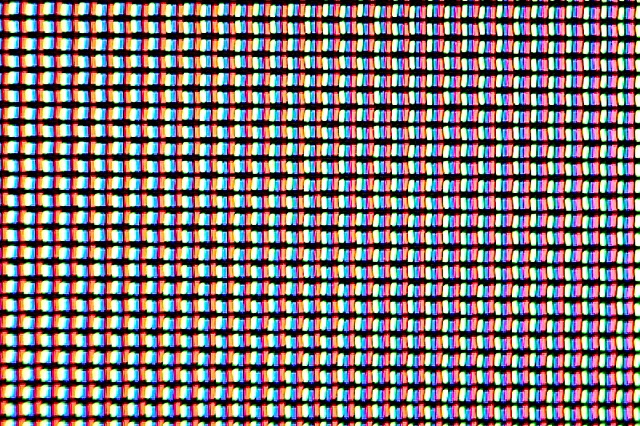
The other question was whether Nexus 5 also uses a PSR (Panel Self Refresh) type display. This display is indeed a MIPI command mode panel, the same kind of system, so yes it does include those features. An additional change is the addition of software vsync in Android 4.4, which to my knowledge the Nexus 5 does use, you can see this pop on and off depending on what’s happening on-screen if you monitor surfaceflinger. Those improvements should decrease latency and improve how sticky animations feel.
To characterize display quality and accuracy, we turn to our usual display measurements.
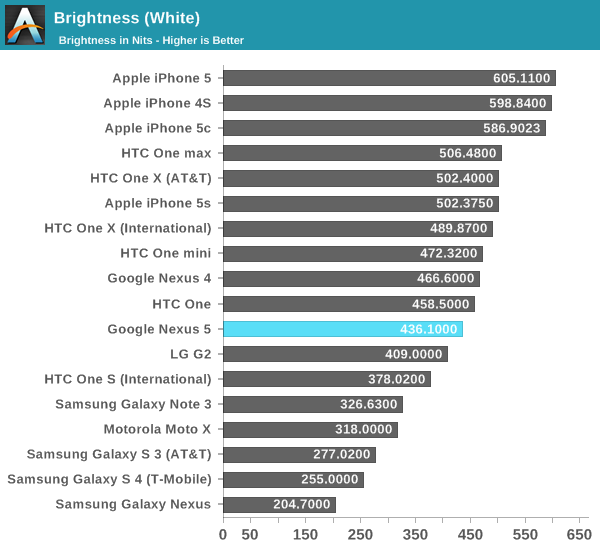
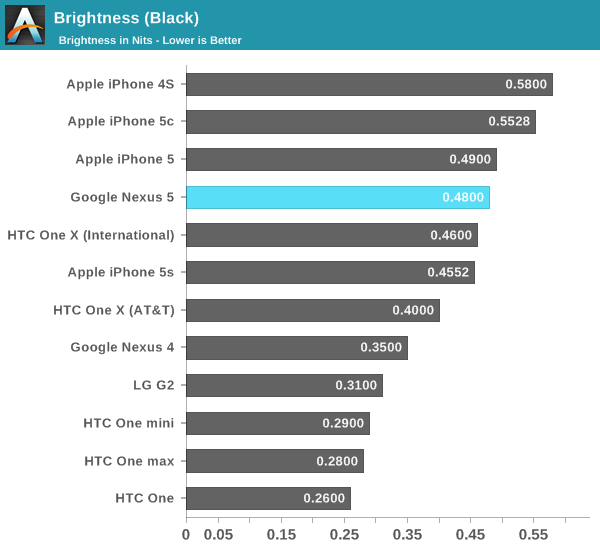
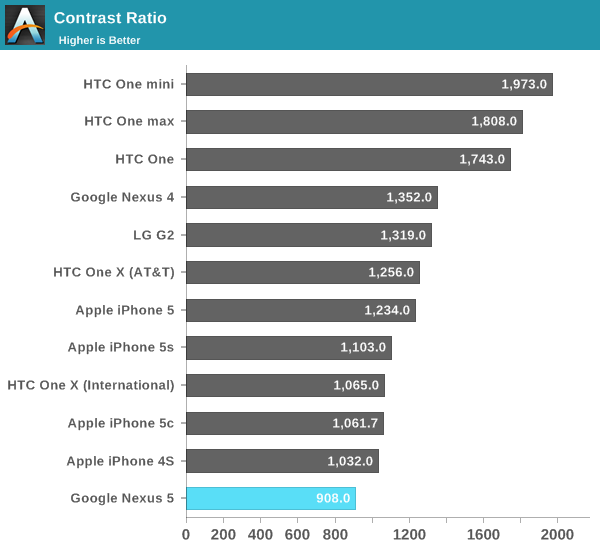
The Nexus 5 doesn’t go quite as bright as Nexus 4, but it’s still a very bright display. Blacks and contrast are a bit disappointing though, contrast is definitely on the lower end, but not bad. I definitely haven’t been put off by them. I also haven’t noticed any of the distracting dynamic brightness behavior I have on other handsets, which is awesome.
My only criticism is that I wish Nexus 5 would allow its auto screen brightness algorithm to go dimmer when in dark scenarios. There’s still more dynamic range in the manual brightness setting bar than there is for the auto brightness routine from what I can tell.

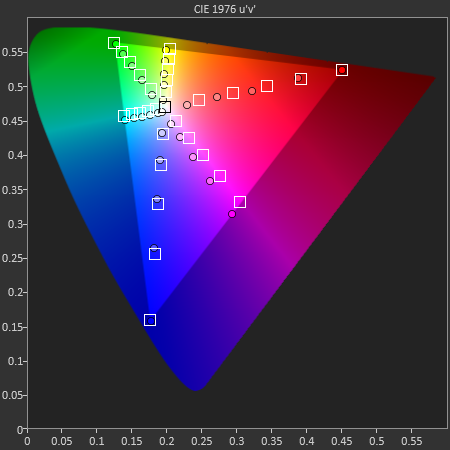
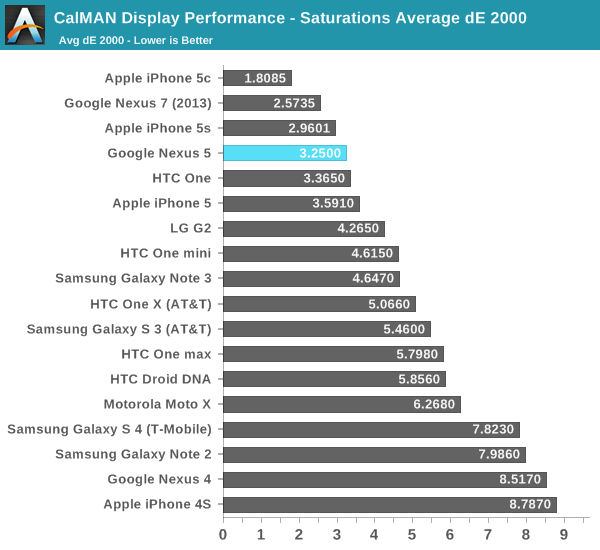
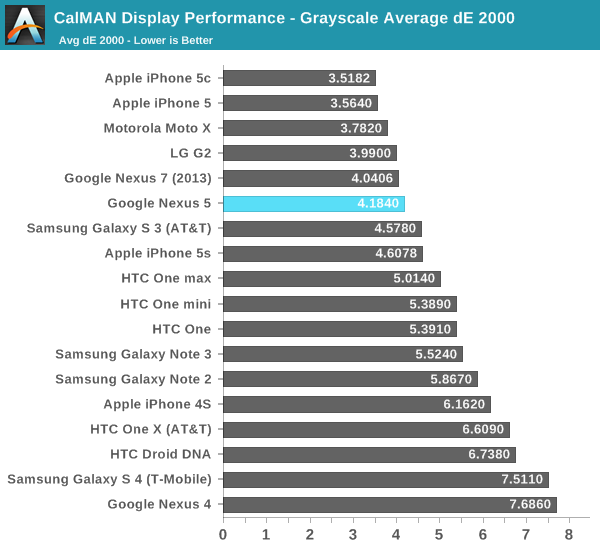
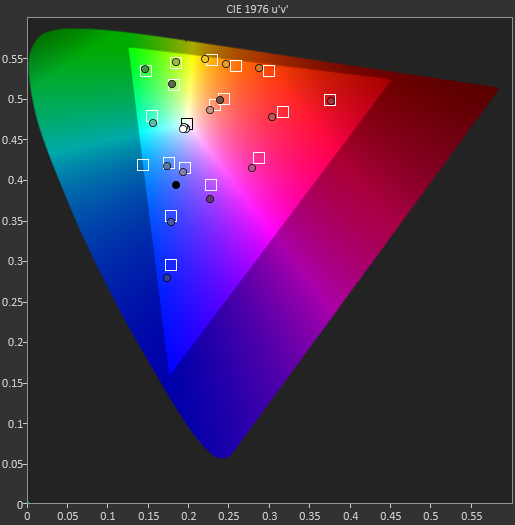
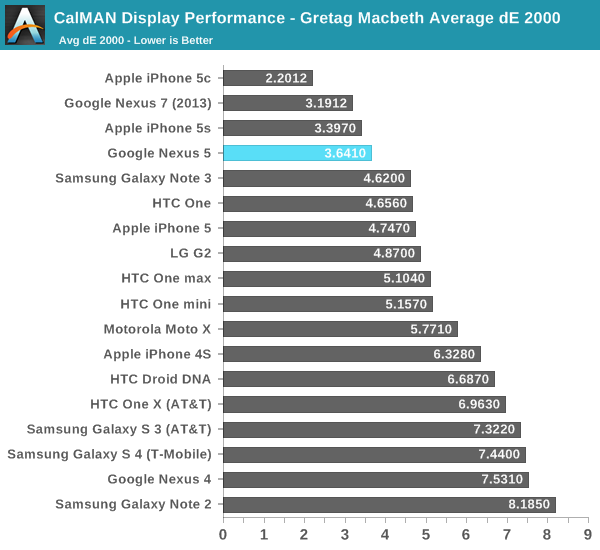
The new Nexus 7 impressed me with how accurate its display was in terms of color reproduction, beginning with Google stating it targeted sRGB (the color space for both the web and Android) calibration for it. The Nexus 5 seems to have done the same, and wowed me with the best GMB color checker Delta-Es we’ve seen from any Android handset. In addition, the Nexus 5 has none of the saturation boost that’s sadly quite pervasive right now, instead giving the right evenly spaced saturation stepping on its color channels. The Nexus 7 has slightly lower Delta-E, but it’s clear to me that Google has made color calibration an emphasis on the Nexus line.
It’s interesting to hear some Nexus 5 users complain that the display seems undersaturated, since that kind of end user feedback reflects subjective comparison. It also suggests to me that a large percentage of the population doesn’t know what some colors or system elements actually should be. Even for me, looking at the green elements inside the Google Play store on the Note 3 in movie mode or Nexus 5 initially seemed slightly more muted than normal. The reality is that this is what they actually should look like. We’ve just become accustomed to their oversaturated appearance on virtually every other device.
This kind of expectation about what looks right and what doesn’t is rather telling for the state of display calibration in Android handsets, and how OEMs have used oversaturated colors to increase retail shelf appeal. Unfortunately the reality is that oversaturated colors do seem to win taste tests among shoppers, the same way that TVs in most big boxes do. We’ve been looking at them for so long that well calibrated displays like Nexus 5 initially do look noticeably different.
The end result is easy to sum up, however – Nexus 5 has the best calibrated display I’ve seen so far in any Android handset. It’s also leaps and bounds more accurate and controlled than its predecessor display in the Nexus 4.


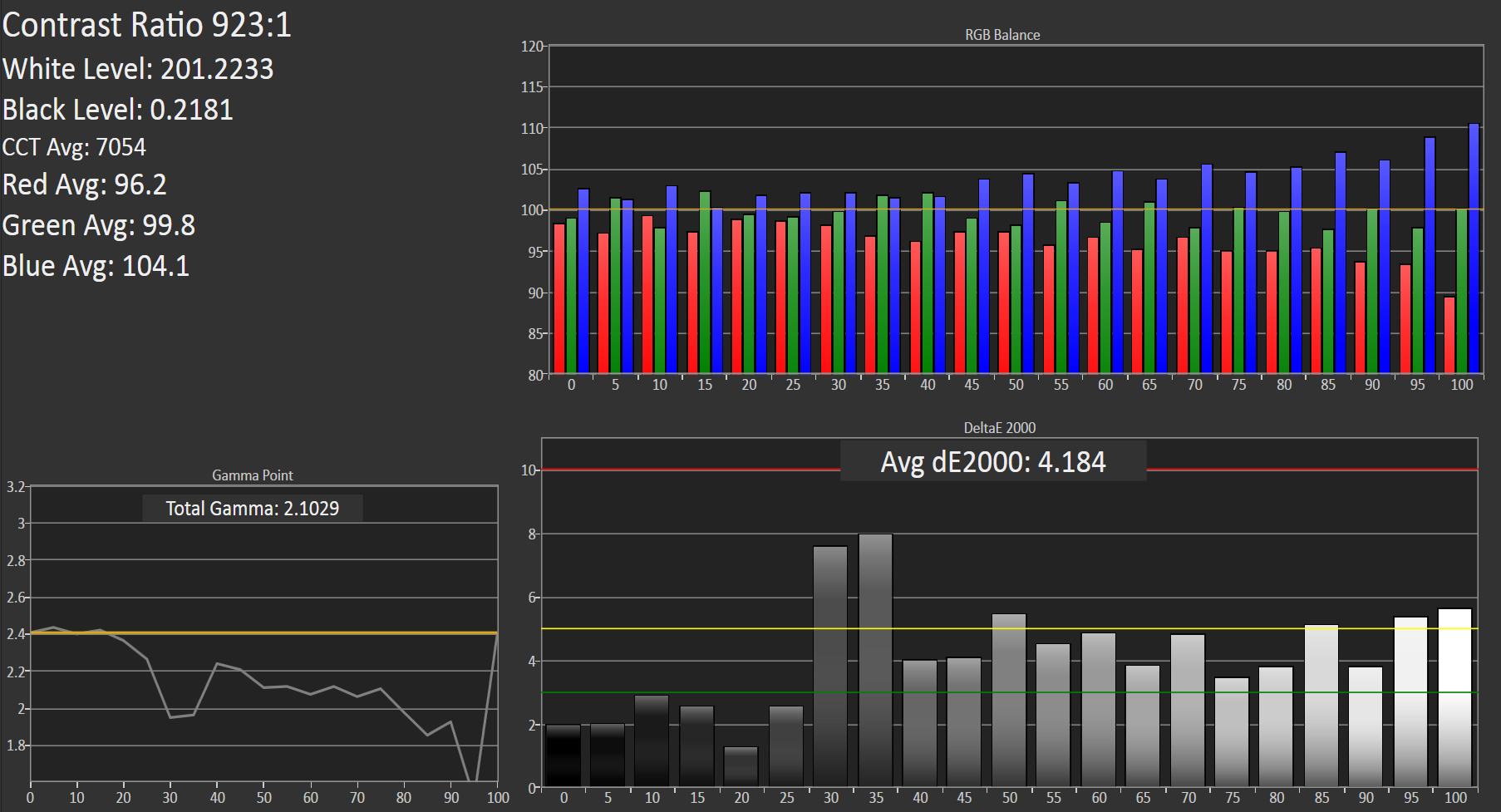








231 Comments
View All Comments
pierrot - Saturday, December 14, 2013 - link
Anyone have speaker sound quality problems? Sounds worse than my Galaxy S1! Its static-y and fuzzy sounding on 4.4.2.blzd - Sunday, December 15, 2013 - link
Not here. They were quiet before now they're quite loud (after 4.4.2). The quality was always above average for me and even the highest volumes have minimal distortion.Anandtech showed the top 2 or 3 volumes with headphones is more or less broken and should not be used though.
mike8675309 - Monday, December 16, 2013 - link
I just picked up a Nexus 5 and it prompted for the 4.4.2 update so I can't say before the update. But currently my only issue with sound is that it can't seem to go low enough. On the volume scale when turning down the notification and other sounds it is like I want to go one step quieter but that next step is vibrate. Seems that there isn't enough range.mateor - Sunday, December 15, 2013 - link
I learned a bunch about all aspects of hardware from this review. Excellent.NexusJohn - Monday, December 16, 2013 - link
Brian, first of all thank you for the awesome, complete review! But I have one lingering question I can't seem to find an answer to: if the snapdragon 800 has a low power core that can be used for "always on" listening (hardware), why can't someone create an app (software) that takes advantage of it like in the moto x?omaudio - Tuesday, December 17, 2013 - link
Hello,What I would really love to see added to phone reviews on AT is whether or not the GPS will function without cellular connection. In other words if you are without service or in airplane mode, will the GPS functions of the phone still operate? I find more often they do not which is why I still own the HTC Amaze 4g. It is one of the only phones I can rely on the gps along with offline mapping. Important and I hope to see it added to future reviews. Thanks
shanturoy - Tuesday, December 17, 2013 - link
At nearly same price point (in India), Nexus has the edge with the Camera (OSS) and processor. But the others have removable battery, SD card slot, larger battery (for G pro).So, if price is not the differentiating factor, which want would be most desirable among LG Optimus G Pro, Sony Xperia ZL, HTC Butterfly and Nexus?
blzd - Saturday, December 21, 2013 - link
Those phones are barely even in the same league as the Nexus 5. Do you want last years phone or today's phone at last years price?eturk - Wednesday, December 18, 2013 - link
how about updating the article to reflect the updated hardware and kitkat 4.4.2? Seems Google may have addresses the low speaker volume and camera.anirudhs - Saturday, December 21, 2013 - link
After using the HTC Aria for 3 years, I upgraded to the Nexus 5. I had it for a weekend, but felt that it didn't live up to its potential. The screen was gorgeous and the phone was free of bloatware. However, the phone was unwieldy due to the large screen, and the battery life was inconsistent. I am now on the iPhone and am very happy with my purchase. At least as far as the internals go, I will be able to run demanding apps for a long time.The trend towards larger screens on cellphones in the Android space is disturbing. 4.5-4.7 inches would be nice, but any bigger and I would find it hard to hold. The likes of Galaxy Note are best replaced by a combination of a smaller smartphone and a tablet - it is just too big.